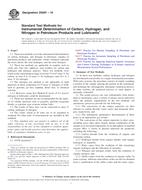Potřebujeme váš souhlas k využití jednotlivých dat, aby se vám mimo jiné mohly ukazovat informace týkající se vašich zájmů. Souhlas udělíte kliknutím na tlačítko „OK“.
ASTM D5291-10
Standard Test Methods for Instrumental Determination of Carbon, Hydrogen, and Nitrogen in Petroleum Products and Lubricants
Automaticky přeložený název:
Standardní zkušební metody pro instrumentální stanovení uhlíku, vodíku a dusíku s ropnými produkty a maziv
NORMA vydána dne 1.5.2010
Informace o normě:
Označení normy: ASTM D5291-10
Poznámka: NEPLATNÁ
Datum vydání normy: 1.5.2010
Kód zboží: NS-30611
Počet stran: 8
Přibližná hmotnost: 24 g (0.05 liber)
Země: Americká technická norma
Kategorie: Technické normy ASTM
Anotace textu normy ASTM D5291-10 :
Keywords:
carbon content, CHN analysis, CHN instruments, hydrogen content, nitrogen content, Additives--petroleum products, Carbon content--petroleum products, CHN (carbon/hydrogen/nitrogen) analysis, Crude petroleum products, Fuel oils, Hydrogen content--petroleum products, Instrumental measurement--petroleum products, Lubricants (fluid), Lubricating oils, Nitrogen content--petroleum products, ICS Number Code 75.080 (Petroleum products in general)
Doplňující informace
| Significance and Use | ||||||
|
This is the first ASTM standard covering the simultaneous determination of carbon, hydrogen, and nitrogen in petroleum products and lubricants. Carbon, hydrogen, and particularly nitrogen analyses are useful in determining the complex nature of sample types covered by this test method. The CHN results can be used to estimate the processing and refining potentials and yields in the petrochemical industry. The concentration of nitrogen is a measure of the presence of nitrogen containing additives. Knowledge of its concentration can be used to predict performance. Some petroleum products also contain naturally occurring nitrogen. Knowledge of hydrogen content in samples is helpful in addressing their performance characteristics. Hydrogen to carbon ratio is useful to assess the performance of upgrading processes. |
||||||
| 1. Scope | ||||||
|
1.1 These test methods cover the instrumental determination of carbon, hydrogen, and nitrogen in laboratory samples of petroleum products and lubricants. Values obtained represent the total carbon, the total hydrogen, and the total nitrogen. 1.2 These test methods are applicable to samples such as crude oils, fuel oils, additives, and residues for carbon and hydrogen and nitrogen analysis. These test methods were tested in the concentration range of at least 75 to 87 mass % for carbon, at least 9 to 16 mass % for hydrogen, and <0.1 to 2 mass % for nitrogen. 1.3 The nitrogen test method is not applicable to light materials or those containing <0.75 mass % nitrogen, or both, such as gasoline, jet fuel, naphtha, diesel fuel, or chemical solvents. 1.3.1 However, using Test Method D levels of 0.1 mass% nitrogen in lubricants could be determined. 1.4 These test methods are not recommended for the analysis of volatile materials such as gasoline, gasoline-oxygenate blends, or gasoline type aviation turbine fuels. 1.5 The results of these tests can be expressed as mass % carbon, hydrogen or nitrogen. 1.6 The values stated in SI units are to be regarded as standard. No other units of measurement are included in this standard. 1.7 This standard does not purport to address all of the safety concerns, if any, associated with its use. It is the responsibility of the user of this standard to establish appropriate safety and health practices and determine the applicability of regulatory limitations prior to use. |
||||||
| 2. Referenced Documents | ||||||
|
Doporučujeme:
Aktualizace technických norem
Chcete mít jistotu, že používáte pouze platné technické normy?
Nabízíme Vám řešení, které Vám zajistí měsíční přehled o aktuálnosti norem, které používáte.
Chcete vědět více informací? Podívejte se na tuto stránku.




 Cookies
Cookies
